Performance Evaluation of TGFS Typhoon Track Forecasts over the Western North Pacific with Sensitivity Tests on Cumulus Parameterization
Abstract
:1. Introduction
2. Model, Data, and Diagnostic Methodology
2.1. The TGFS Model
2.2. Statistical Analysis and Experimental Design
2.3. Diagnosis of Vorticity Budget and Regressed Typhoon Motion
3. TGFS Typhoon Track Forecast and Cumulus Parameterization Tests
3.1. Statistical Analysis of Typhoon Track Error
3.2. Sensitivity Tests of NTDK Cumulus Parameterization
3.2.1. Summer Typhoons with Typical Wpsh Characteristic
3.2.2. Typhoon Bolaven (2023) in October
4. Conclusions and Discussion
Author Contributions
Funding
Institutional Review Board Statement
Informed Consent Statement
Data Availability Statement
Acknowledgments
Conflicts of Interest
References
- Liou, C.S.; Chen, J.H.; Terng, C.T.; Wang, F.J.; Fong, C.T.; Rosmond, T.E.; Kuo, H.C.; Shiao, C.H.; Cheng, M.D. The Second–Generation Global Forecast System at the Central Weather Bureau in Taiwan. Weather Forecast. 1997, 12, 653–663. [Google Scholar] [CrossRef]
- Su, C.Y.; Wu, C.M.; Chen, W.T.; Chen, J.H. Objectbased precipitation system bias in grey zone simulation: The 2016 South China Sea summer monsoon onset. Clim. Dyn. 2019, 53, 617–630. [Google Scholar] [CrossRef]
- Robert, A. A stable numerical integration scheme for the primitive meteorological euations. Atmos.-Ocean. 1981, 19, 35–46. [Google Scholar] [CrossRef]
- Juang, H.M.H. Semi-Lagrangian advection without iteration. In Proceedings of the Conference on Weather Analysis and Forecasting, Central Weather Bureau, Longtan, Taoyan, Taiwan, China, 23–26 January 2017; p. 277. [Google Scholar]
- Juang, H.M.H. Mass conserving and positive-definite semi-Lagrangian advection in NCEP GFS: Decomposition of massively parallel computing without halo. In Proceedings of the Thirteenth Workshop on Use of High Performance Computing in Meteorology, European Centre for Medium-Range Weather Forecasts, Reading, UK, 4 November 2008; pp. 3–7. [Google Scholar]
- Liu, P.Y.; Chen, J.H.; Juang, H.M. Use of non-iteration dimensional-split semi-Lagrangian (NDSL) in Central Weather Bureau global forecast system. In Proceedings of the 25th Conference on Numerical Weather Prediction, Denver, CO, USA, 3–8 June 2018; American Meteorological Society: Boston, MA, USA 12B.6. [Google Scholar]
- Zhao, Q.; Carr, F.H. A prognostic cloud scheme for operational NWP models. Mon. Weather Rev. 1997, 125, 1931–1953. [Google Scholar] [CrossRef]
- Lin, S.J. A finite-volume integration method for computing pressure gradient force in general vertical coordinates. Q. J. R. Meteorol. Soc. 1997, 123, 1749–1762. [Google Scholar] [CrossRef]
- Lin, S.J.; Rood, R.B. An explicit flux-form semi-Lagrangian shallow-water model on the sphere. Q. J. R. Meteorol. Soc. 1997, 123, 2477–2498. [Google Scholar]
- Lin, S.J. A “vertically Lagrangian” finite-volume dynamical core for global models. Mon. Weather Rev. 2004, 132, 2293–2307. [Google Scholar] [CrossRef]
- Putman, W.M.; Lin, S.J. Finite-volume transport on various cubed-sphere grids. J. Comput. Phys. 2007, 227, 55–78. [Google Scholar] [CrossRef]
- Kleist, D.; Mahajan, R.; Thomas, C. Data assimilation in the next-generation global prediction system (NGGPS) era: Initial implementation of FV3-based global forecast system (GFS). JCSDA Q. 2018, 61, 34. [Google Scholar]
- Chen, J.H.; Lin, S.J.; Magnusson, L.; Bender, M.; Chen, X.; Zhou, L.; Xiang, B.; Rees, S.; Morin, M.; Harris, L. Advancements in hurricane prediction with NOAA’s next-generation forecast system. Geophys. Res. Lett. 2019, 46, 4495–4501. [Google Scholar] [CrossRef]
- Wang, W.; Han, J.; Shin, J.; Chen, X.; Hazelton, A.; Zhu, L.; Kim, H.S.; Li, X.; Liu, B.; Liu, Q.; et al. Physics schemes in the first version of NCEP operational hurricane analysis and forecast system (HAFS). Front. Earth Sci. 2024, 12, 1379069. [Google Scholar] [CrossRef]
- Dong, J.; Liu, B.; Zhang, Z.; Wang, W.; Mehra, A.; Hazelton, A.T.; Winterbottom, H.R.; Zhu, L.; Wu, K.; Zhang, C.; et al. The evaluation of real-time Hurricane Analysis and Forecast System (HAFS) Stand-Alone Regional (SAR) model performance for the 2019 Atlantic hurricane season. Atmosphere 2020, 11, 617. [Google Scholar] [CrossRef]
- Huang, C.Y.; Juan, T.C.; Kuo, H.C.; Chen, J.H. Track deflection of Typhoon Maria (2018) during a westbound passage offshore of northern Taiwan: Topographic influence. Mon. Weather Rev. 2020, 148, 4519–4544. [Google Scholar] [CrossRef]
- Huang, C.Y.; Sha, S.H.; Kuo, H.C. A modeling study of Typhoon Lekima (2019) with the topographic influence of Taiwan. Mon. Weather Rev. 2022, 150, 1993–2011. [Google Scholar] [CrossRef]
- Harr, P.A.; Elsberry, R.L. Tropical cyclone track characteristics as a function of large-scale circulation anomalies. Mon. Weather Rev. 1991, 119, 1448–1468. [Google Scholar] [CrossRef]
- Harr, P.A.; Elsberry, R.L. Large-scale circulation variability over the tropical western North Pacific. Part I: Spatial patterns and tropical cyclone characteristics. Mon. Weather Rev. 1995, 123, 1225–1246. [Google Scholar] [CrossRef]
- Harr, P.A.; Elsberry, R.L. Large-scale circulation variability over the tropical western North Pacific. Part II: Persistence and transition characteristics. Mon. Weather Rev. 1995, 123, 1247–1268. [Google Scholar] [CrossRef]
- Carr, L.E., III; Elsberry, R.L. Dynamical tropical cyclone track forecast errors. Part I: Tropical region error sources. Weather Forecast. 2000, 15, 641–661. [Google Scholar] [CrossRef]
- Chu, P.S.; Kim, J.H.; Chen, Y.R. Have steering flows in the western North Pacific and the South China Sea changed over the last 50 years? Geophys. Res. Lett. 2012, 39, L10704. [Google Scholar] [CrossRef]
- Zhao, H.; Wu, L. Inter-decadal shift of the prevailing tropical cyclone tracks over the western North Pacific and its mechanism study. Meteorol. Atmos. Phys. 2014, 125, 89–101. [Google Scholar] [CrossRef]
- Tiedtke, M. A comprehensive mass flux scheme for cumulus parameterization in large scale models. Mon. Weather Rev. 1989, 117, 1779–1800. [Google Scholar] [CrossRef]
- Torn, R.D.; Davis, C.A. The influence of shallow convection on tropical cyclone track forecasts. Mon. Weather Rev. 2012, 140, 2188–2197. [Google Scholar] [CrossRef]
- Parker, C.L.; Lynch, A.H.; Mooney, P.A. Factors affecting the simulated trajectory and intensification of Tropical Cyclone Yasi (2011). Atmos. Res. 2017, 194, 27–42. [Google Scholar] [CrossRef]
- Delfino, R.J.; Bagtasa, G.; Hodges, K.; Vidale, P.L. Sensitivity of simulating Typhoon Haiyan (2013) using WRF: The role of cumulus convection, surface flux parameterizations, spectral nudging, and initial and boundary conditions. Nat. Hazards Earth Syst. Sci. 2022, 22, 3285–3307. [Google Scholar] [CrossRef]
- Bechtold, P.; Semane, N.; Lopez, P.; Chaboureau, J.P.; Beljaars, A.; Bormann, N. Representing equilibrium and nonequilibrium convection in large-scale models. J. Atmos. Sci. 2014, 71, 734–753. [Google Scholar] [CrossRef]
- Han, J.; Witek, M.L.; Teixeira, J.; Sun, R.; Pan, H.L.; Fletcher, J.K.; Bretherton, C.S. Implementation in the NCEP GFS of a hybrid eddy-diffusivity mass-flux (EDMF) boundary layer parameterization with dissipative heating and modified stable boundary layer mixing. Weather Forecast. 2016, 31, 341–352. [Google Scholar] [CrossRef]
- Chen, F.; Dudhia, J. Coupling an advanced land surface-hydrology model with the Penn State-NCAR MM5 modeling system. Part I: Model implementation and sensitivity. Mon. Weather Rev. 2001, 129, 569–585. [Google Scholar] [CrossRef]
- Ek, M.B.; Mitchell, K.E.; Lin, Y.; Rogers, E.; Grunmann, P.; Koren, V.; Gayno, G.; Tarpley, J.D. Implementation of Noahland surface model advances in the National Centers for Environ-mental Prediction operational mesoscale Eta model. J. Geophys. Res. 2003, 108, 8851. [Google Scholar]
- Chun, H.Y.; Baik, J.J. Weakly nonlinear response of a stably stratified atmosphere to diabatic forcing in a uniform flow. J. Atmos. Sci. 1994, 51, 3109–3121. [Google Scholar] [CrossRef]
- Kim, Y.J.; Arakawa, A. Improvement of orographic gravity wave parameterization using a mesoscale gravity wave model. J. Atmos. Sci. 1995, 52, 1875–1902. [Google Scholar] [CrossRef]
- Kim, Y.J.; Doyle, J.D. Extension of an orographic-drag parameterization scheme to incorporate orographic anisotropy and flow blocking. Q. J. R. Meteorol. Soc. A J. Atmos. Sci. Appl. Meteorol. Phys. Oceanogr. 2005, 131, 1893–1921. [Google Scholar]
- Lin, Y.L.; Farley, R.D.; Orville, H.D. Bulk parameterization of the snow field in a cloud model. J. Climate Appl. Meteor. 1983, 22, 1065–1092. [Google Scholar] [CrossRef]
- Lord, S.J.; Willoughby, H.E.; Piotrowicz, J.M. Role of a parameterized ice-phase microphysics in an axisymmetric, nonhydrostatic tropical cyclone model. J. Atmos. Sci. 1984, 41, 2836–2848. [Google Scholar] [CrossRef]
- Krueger, S.K.; Fu, Q.; Liou, K.N.; Chin, H.N.S. Improvement of an ice-phase microphysics parameterization for use in numerical simulations of tropical convection. J. Appl. Meteorol. 1995, 34, 281–287. [Google Scholar] [CrossRef]
- Chen, J.H.; Lin, S.J. The remarkable predictability of inter-annual variability of Atlantic hurricanes during the past decade. Geophys. Res. Lett. 2011, 38, L11804. [Google Scholar] [CrossRef]
- Chen, J.H.; Lin, S.J. Seasonal predictions of tropical cyclones using a 25-km-resolution general circulation model. J. Clim. 2013, 26, 380–398. [Google Scholar] [CrossRef]
- Mlawer, E.J.; Taubman, S.J.; Brown, P.D.; Iacono, M.J.; Clough, S.A. Radiative transfer for inhomogeneous atmospheres: RRTM, a validated correlated-k model for the longwave. J. Geophys. Res. 1997, 102, 16663–16682. [Google Scholar] [CrossRef]
- Clough, S.A.; Shephard, M.W.; Mlawer, E.J.; Delamere, J.S.; Iacono, M.J.; Cady-Pereira, K.; Boukabara, S.; Brown, P.D. Atmospheric radiative transfer modeling: A summary of the AER codes. J. Quant. Spectrosc. Radiat. Transf. 2005, 91, 233–244. [Google Scholar] [CrossRef]
- Lin, C.H.; Yang, M.J.; Hsiao, L.F.; Chen, J.H. The impact of scale-aware parameterization on the nest-generation global prediction system in Taiwan for front predictions. Atmosphere 2022, 13, 1063. [Google Scholar] [CrossRef]
- Han, J.; Wang, W.; Kwon, Y.C.; Hong, S.Y.; Tallapragada, V.; Yang, F. Updates in the NCEP GFS cumulus convection schemes with scale and aerosol awareness. Weather Forecast. 2017, 32, 2005–2017. [Google Scholar] [CrossRef]
- Arakawa, A.; Schubert, W.H. Interaction of a Cumulus Cloud Ensemble with the Large-Scale Environment, Part I. J. Atmos. Sci. 1974, 31, 674–701. [Google Scholar] [CrossRef]
- Grell, G.A. Prognostic evaluation of assumptions used by cumulus parameterizations. Mon. Weather Rev. 1993, 121, 764–787. [Google Scholar] [CrossRef]
- Han, J.; Pan, H.L. Revision of convection and vertical diffusion schemes in the NCEP global forecast system. Weather Forecast. 2011, 26, 520–533. [Google Scholar] [CrossRef]
- Arakawa, A.; Wu, C.M. A Unified representation of deep moist convection in numerical modeling of the Atmosphere. Part I. J. Atmos. Sci. 2013, 70, 1977–1992. [Google Scholar] [CrossRef]
- Grell, G.A.; Freitas, S.R. A scale and aerosol aware stochastic convective parameterization for weather and air quality modeling. Atmos. Chem. Phys. 2014, 14, 5233–5250. [Google Scholar] [CrossRef]
- Wu, L.; Wang, B. A potential vorticity tendency diagnostic approach for tropical cyclone motion. Mon. Weather Rev. 2000, 128, 1899–1911. [Google Scholar] [CrossRef]
- Huang, C.Y.; Zhang, Y.; Skamarock, W.C.; Hsu, L.H. Influences of large-scale flow variations on the track evolution of Typhoons Morakot (2009) and Megi (2010): Simulations with a global variable-resolution model. Mon. Weather Rev. 2017, 145, 1691–1716. [Google Scholar] [CrossRef]
- Goerss, J.S. Prediction of consensus tropical cyclone track forecast error. Mon. Weather Rev. 2007, 135, 1985–1993. [Google Scholar] [CrossRef]
- Yu, H.; Chen, G.; Brown, B. A new verification measure for tropical cyclone track forecasts and its experimental application. Trop. Cyclone Res. Rev. 2013, 2, 185–195. [Google Scholar]
- Zhang, C.; Wang, Y.; Hamilton, K. Improved representation of boundary layer clouds over the southeast Pacific in ARW-WRF using a modified Tiedtke cumulus parameterization scheme. Mon. Weather Rev. 2011, 139, 3489–3513. [Google Scholar] [CrossRef]
- Liu, Q.; Zhang, X.; Tong, M.; Zhang, Z.; Liu, B.; Wang, W.; Zhu, L.; Zhang, B.; Xu, X.; Trahan, S.; et al. Vortex initialization in the NCEP operational hurricane models. Atmosphere 2020, 11, 968. [Google Scholar] [CrossRef]

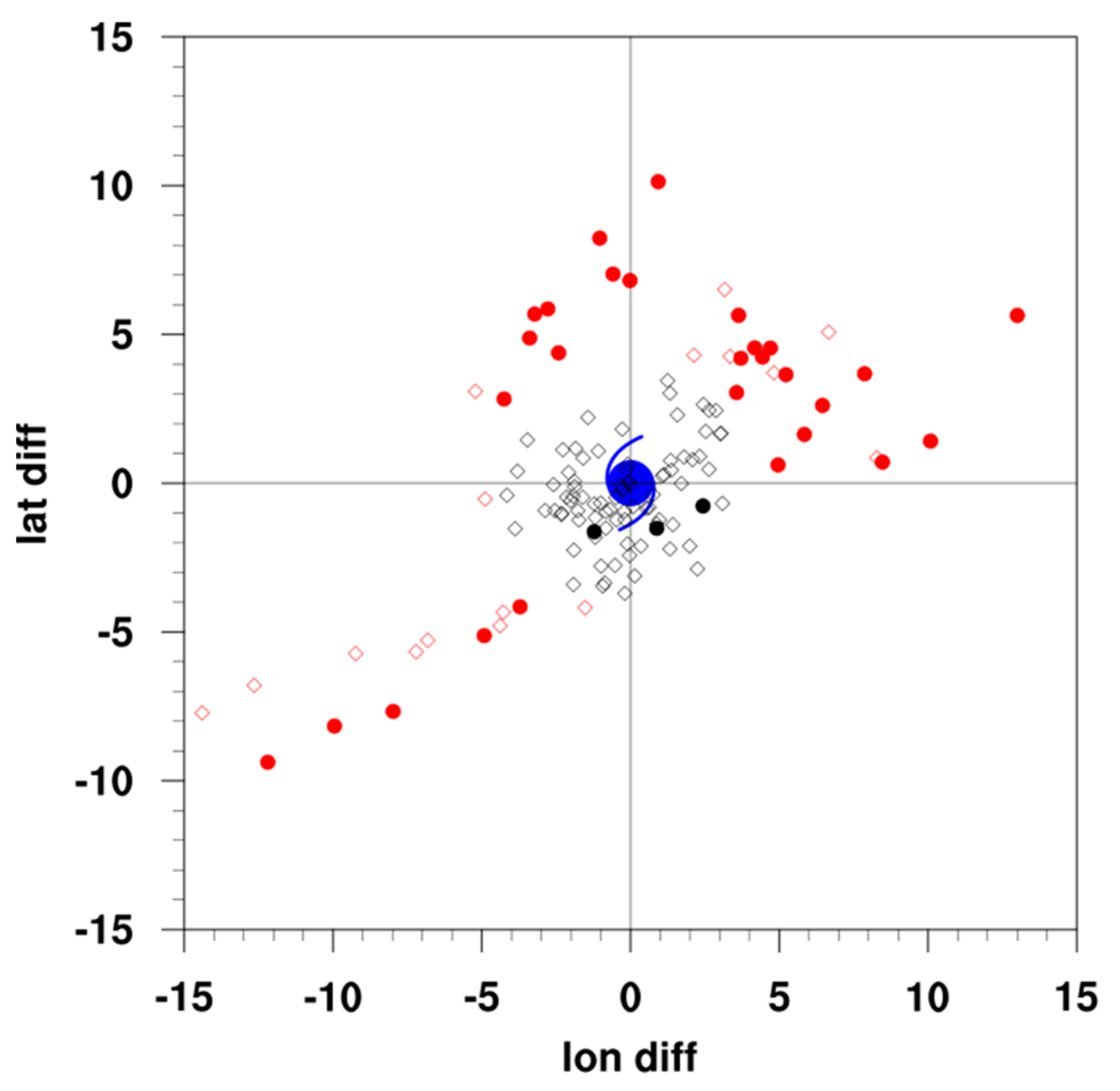
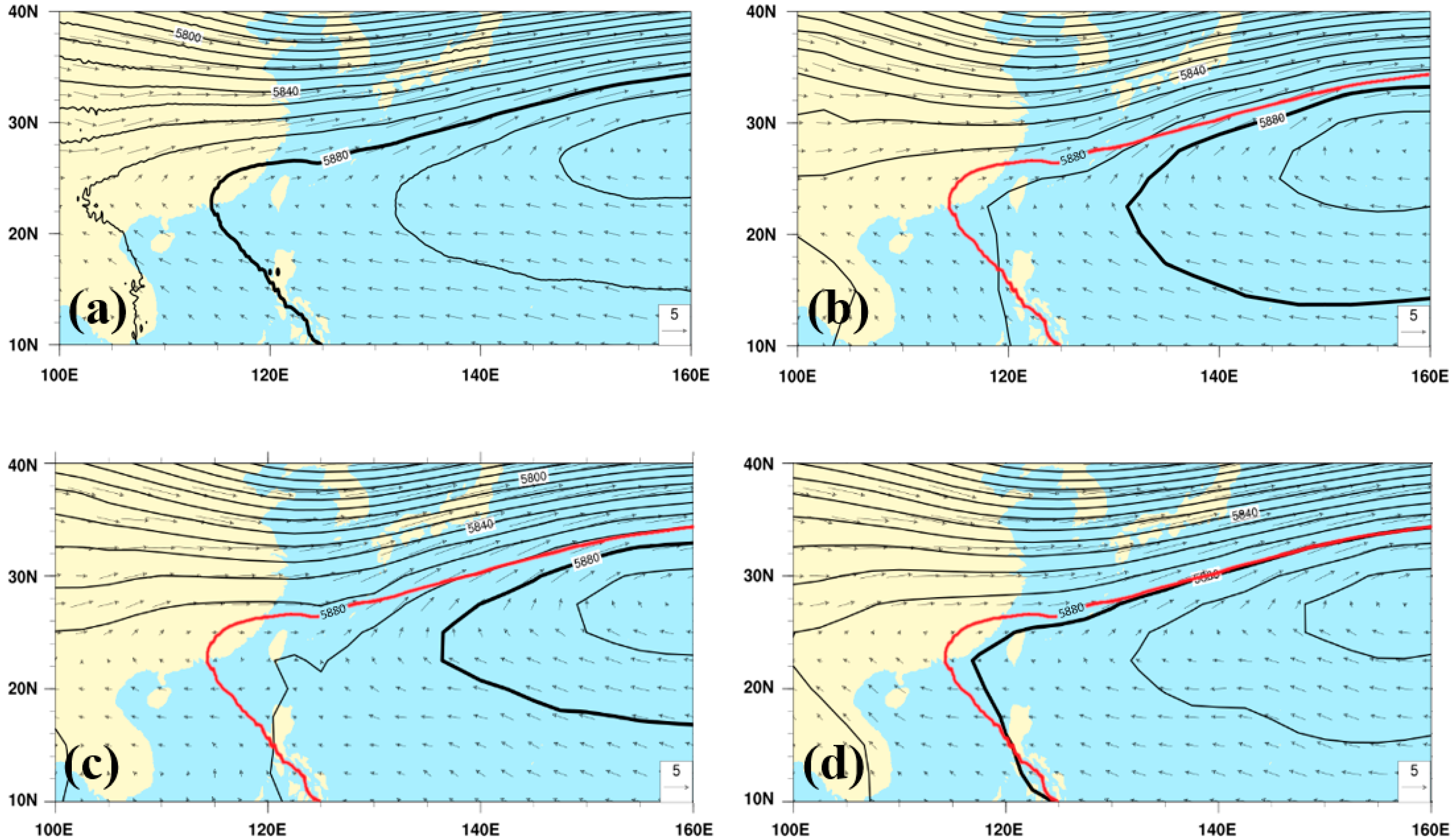
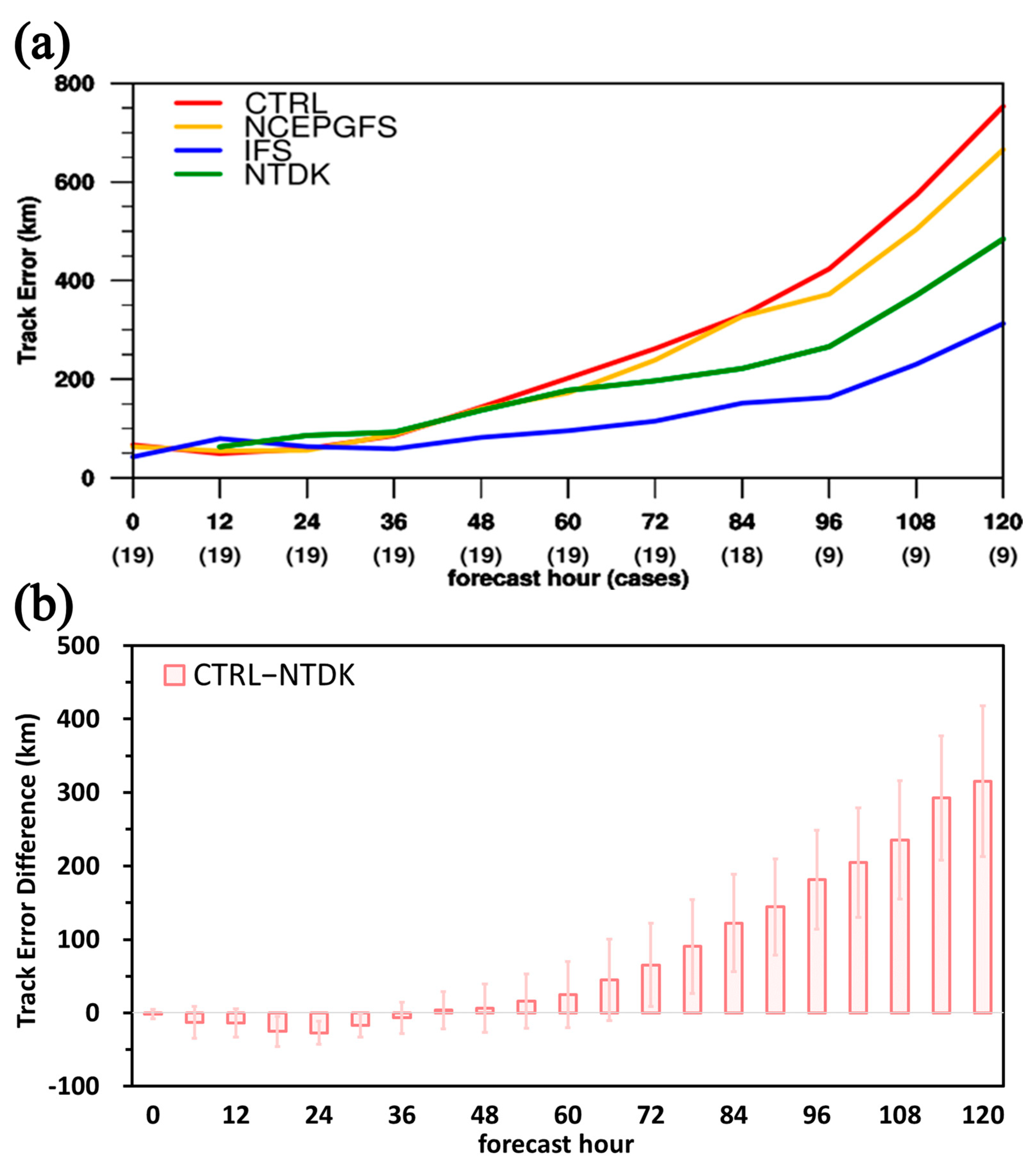

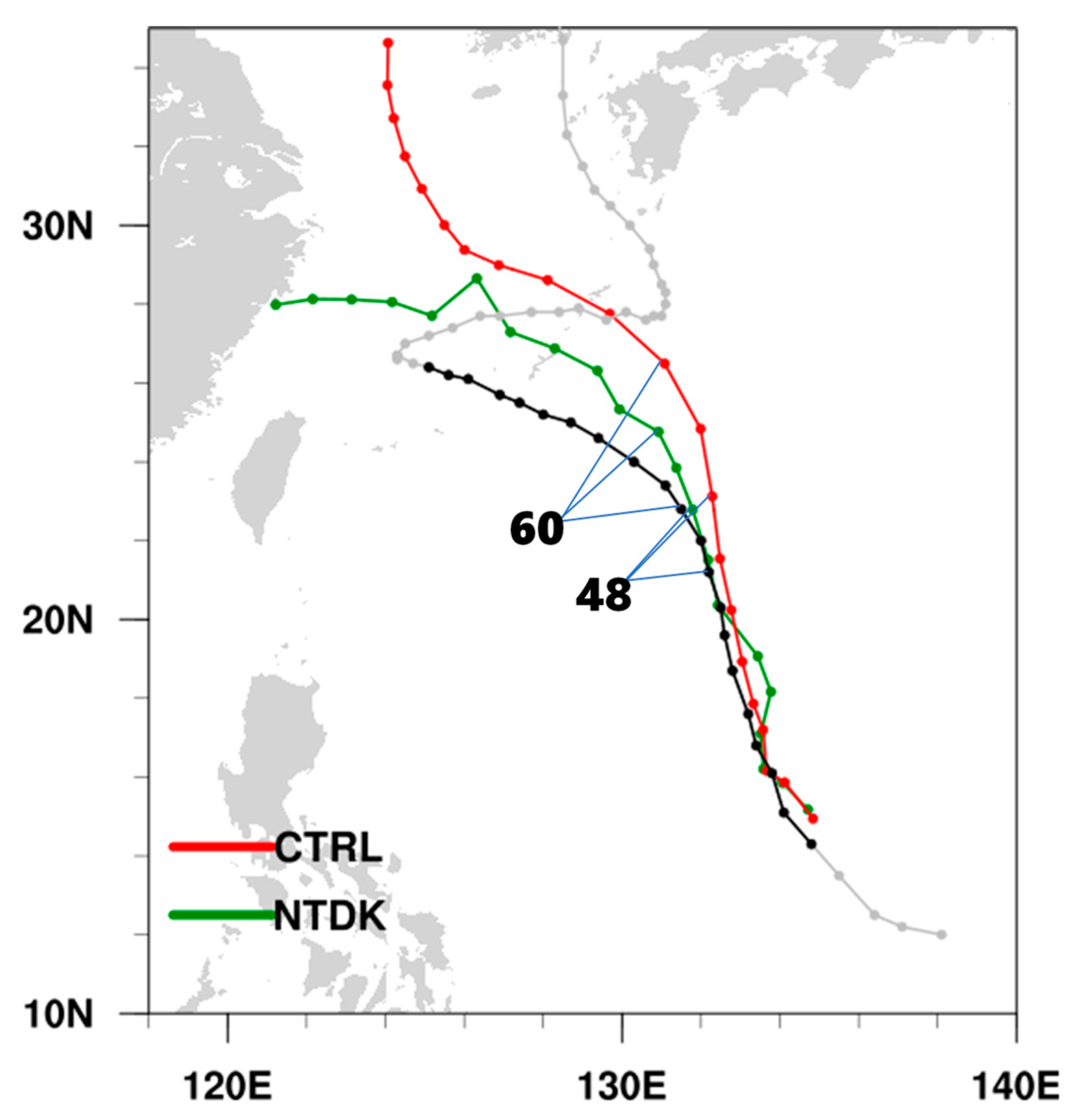
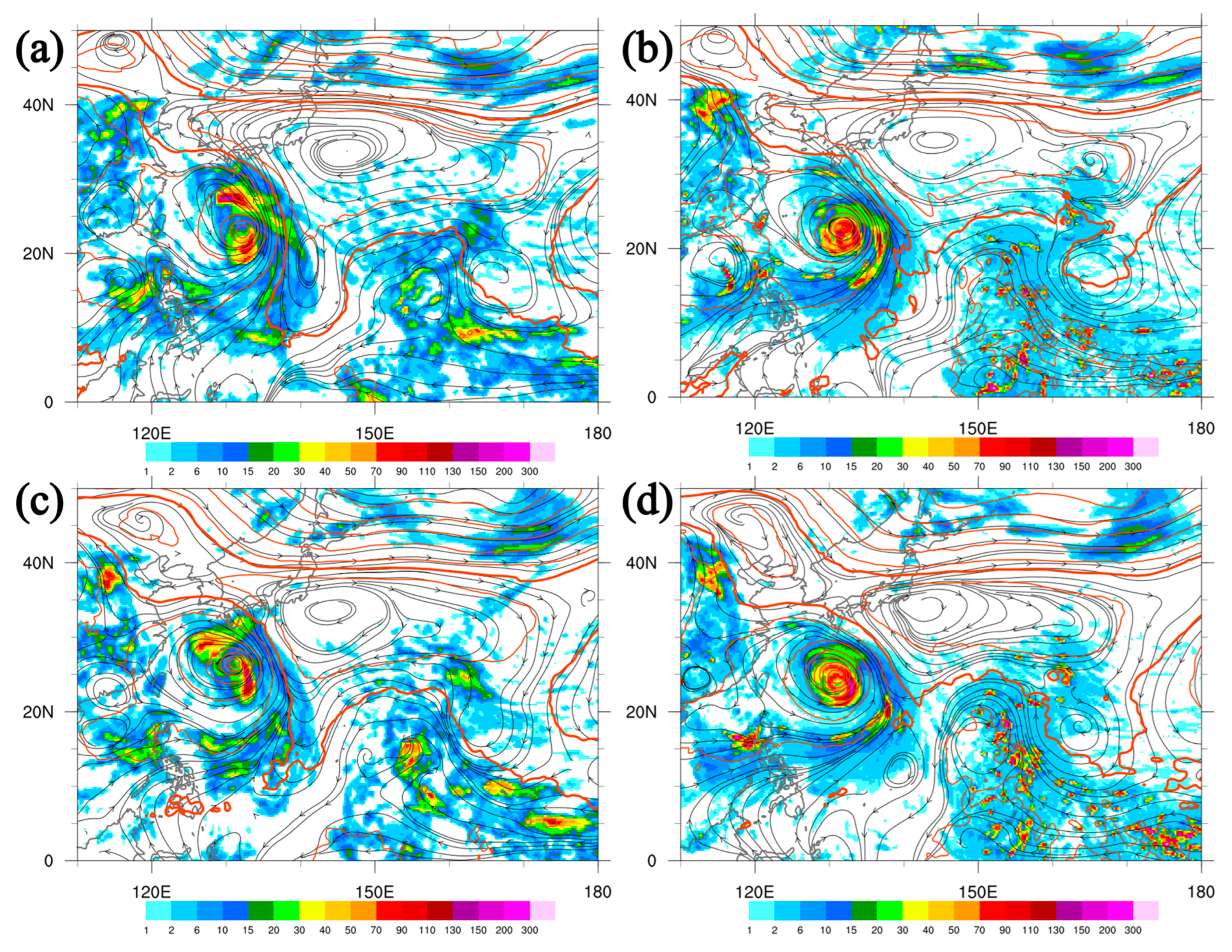
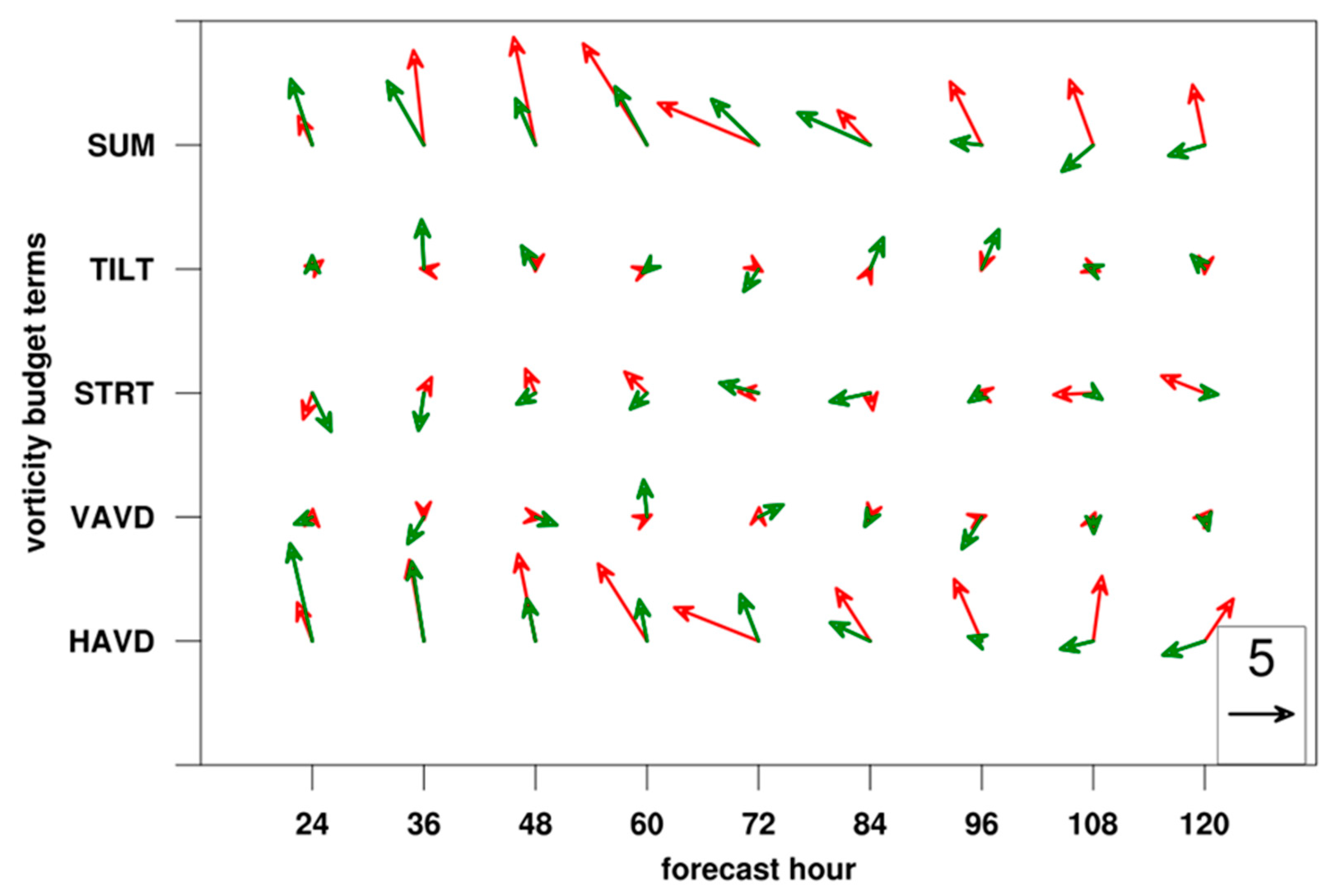
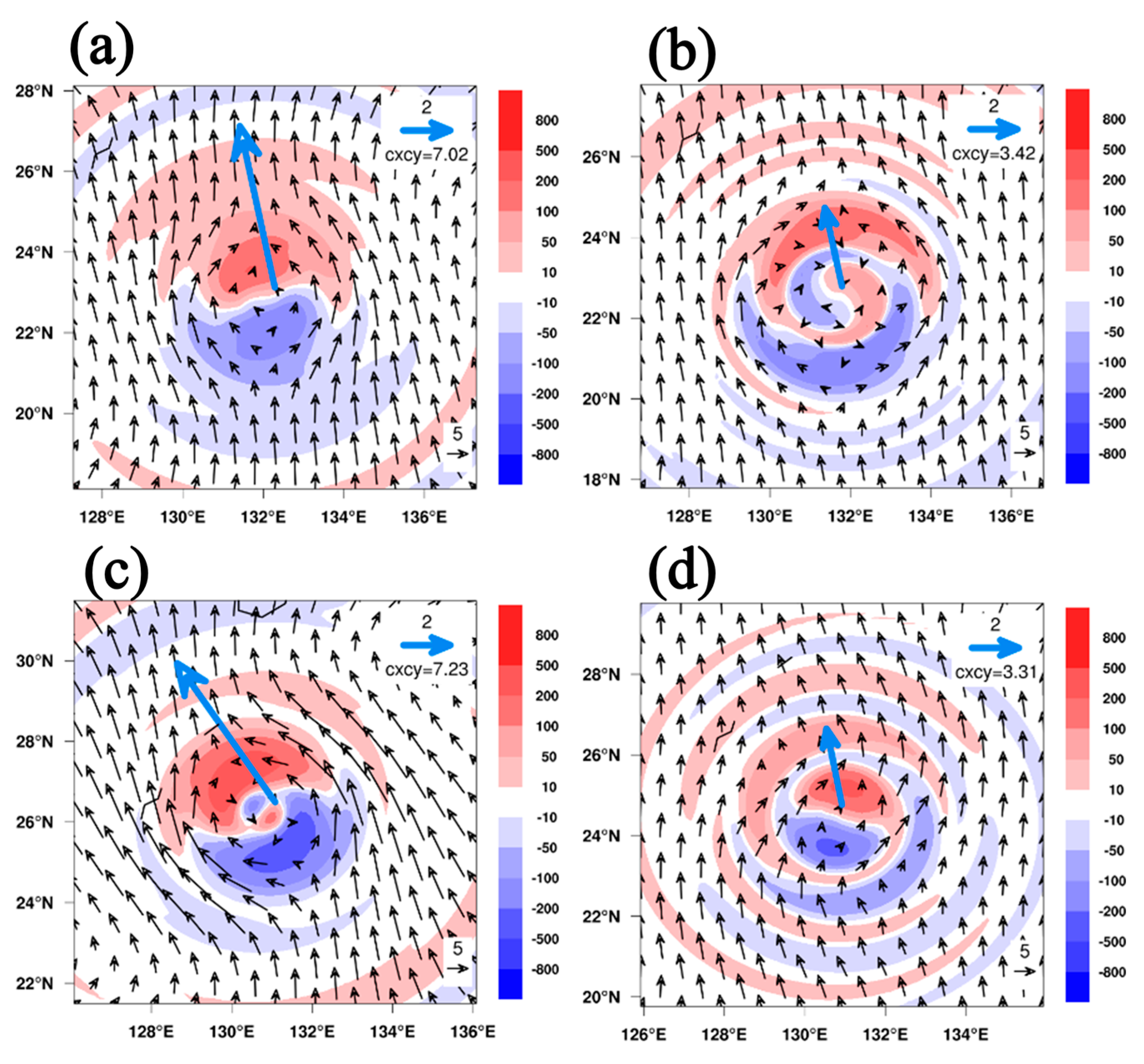
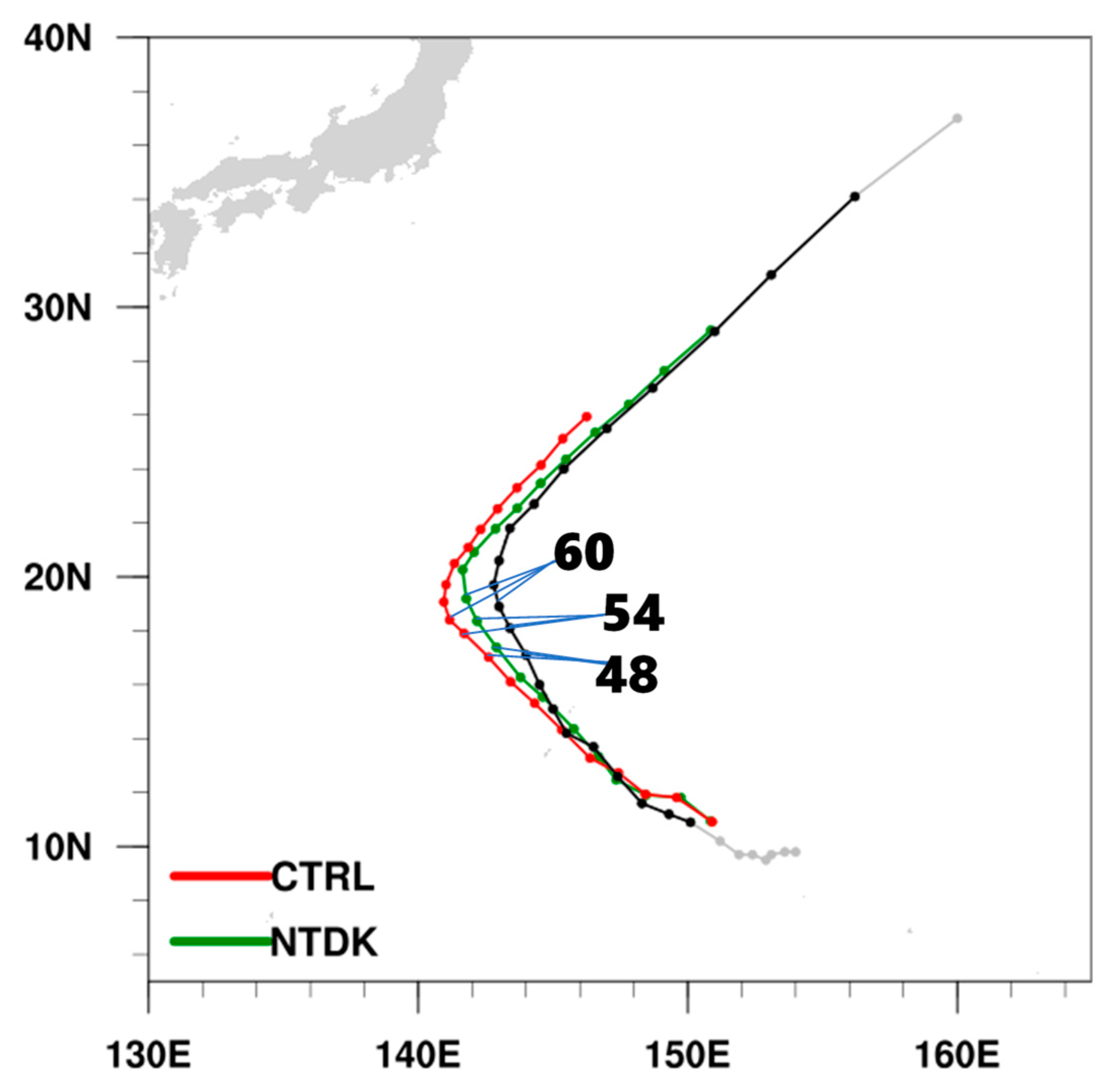
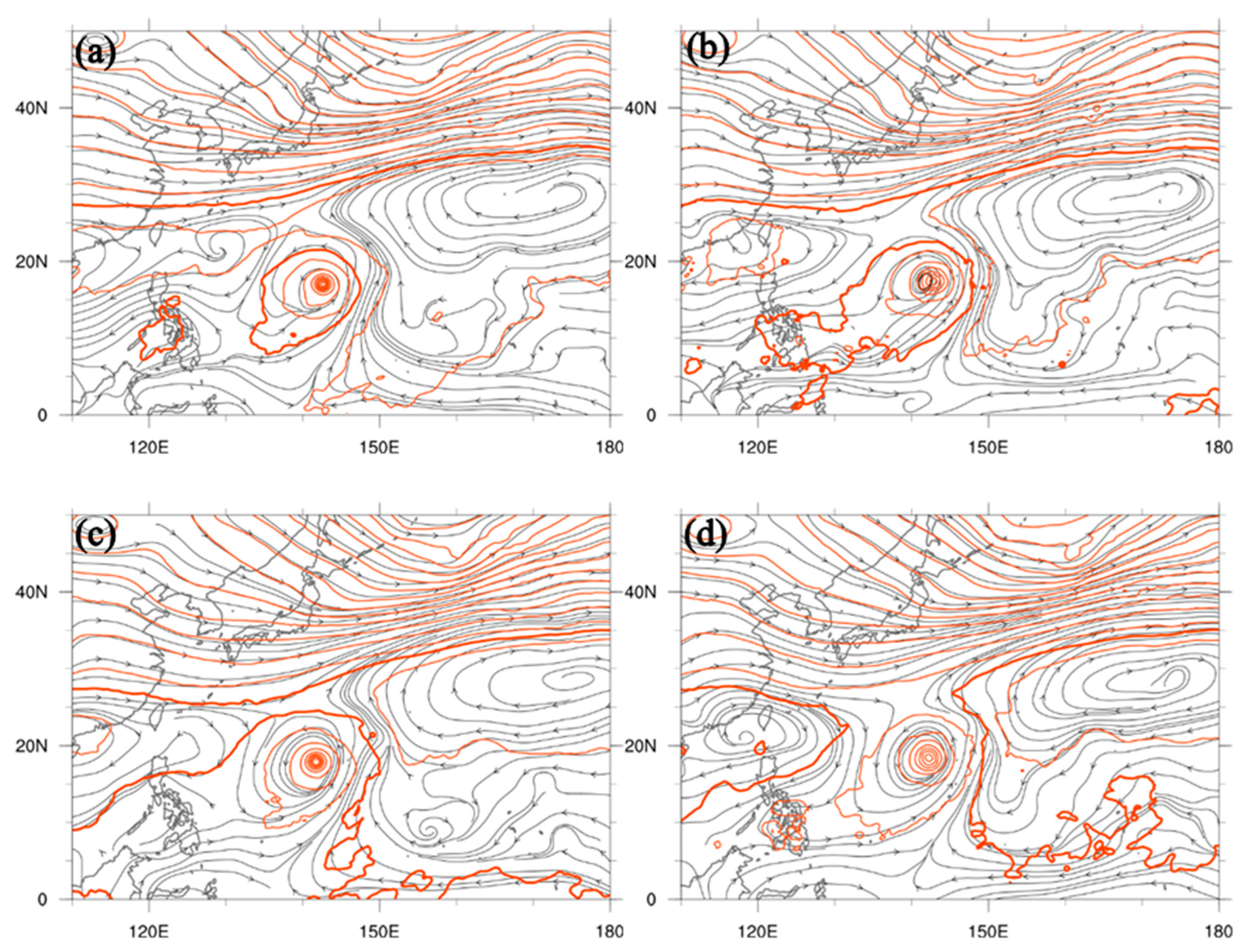
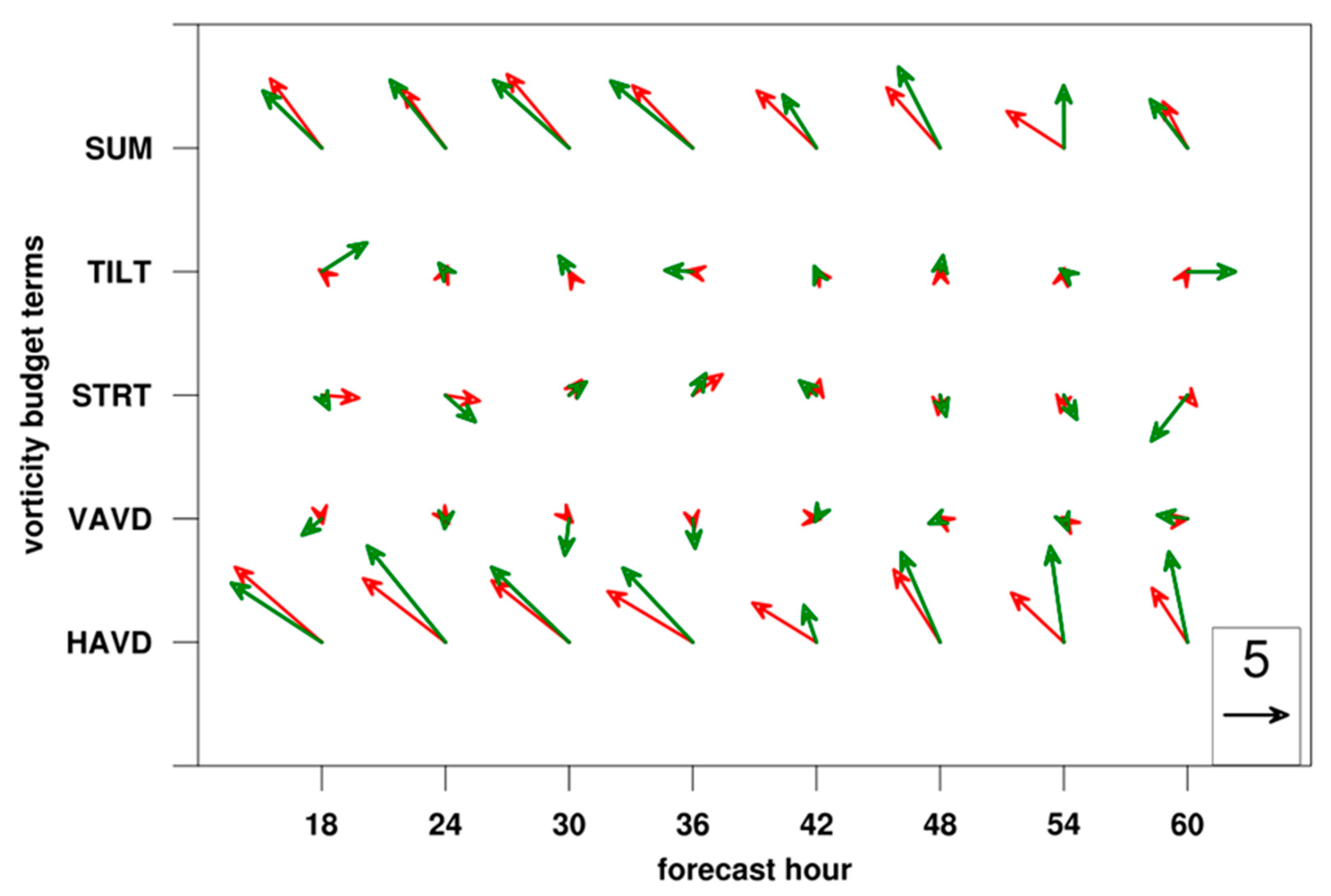

| Model Settings | TGFS |
|---|---|
| Domain | Global C384TL64 (~25 km horizontal resolution in six cubic spherical tiles with 64 vertical layers up to 0.2 hPa) |
| Dynamical core | Finite-Volume Cubed-Sphere (FV3), nonhydrostatic [11] |
| Data assimilation | GSI hybrid 4-dimensional ensemble-variational (4DEnVar) |
| Planetary boundary layer (PBL) scheme | Hybrid eddy-diffusivity mass-flux (EDMF) [29] |
| Land surface model | Noah land surface model [30,31] |
| Deep/shallow cumulus parameterization | CWA modified new simplified Arakawa-Schubert scheme (NSAS) [42,43,44,45,46,47,48] |
| Cloud microphysics | GFDL six-category cloud microphysics scheme [35,36,37,38,39] |
| Shortwave/longwave radiation | Rapid radiative transfer model for general circulation models (RRTMG) [40,41] |
| Typhoon Cases | DTGs (Mmddhh) |
|---|---|
| Doksuri (2023) | 072100, 072106, 072112, 072118, 072200, 072206 |
| Khanun (2023) | 072718, 072806, 072812, 072818 |
| Lan (2023) | 080800, 080900, 080906, 080912 |
| Bolaven (2023) | 100806, 100812, 100818, 100900, 100906 |
Disclaimer/Publisher’s Note: The statements, opinions and data contained in all publications are solely those of the individual author(s) and contributor(s) and not of MDPI and/or the editor(s). MDPI and/or the editor(s) disclaim responsibility for any injury to people or property resulting from any ideas, methods, instructions or products referred to in the content. |
© 2024 by the authors. Licensee MDPI, Basel, Switzerland. This article is an open access article distributed under the terms and conditions of the Creative Commons Attribution (CC BY) license (https://creativecommons.org/licenses/by/4.0/).
Share and Cite
Chen, Y.-H.; Sha, S.-H.; Lin, C.-H.; Hsiao, L.-F.; Huang, C.-Y.; Kuo, H.-C. Performance Evaluation of TGFS Typhoon Track Forecasts over the Western North Pacific with Sensitivity Tests on Cumulus Parameterization. Atmosphere 2024, 15, 1075. https://doi.org/10.3390/atmos15091075
Chen Y-H, Sha S-H, Lin C-H, Hsiao L-F, Huang C-Y, Kuo H-C. Performance Evaluation of TGFS Typhoon Track Forecasts over the Western North Pacific with Sensitivity Tests on Cumulus Parameterization. Atmosphere. 2024; 15(9):1075. https://doi.org/10.3390/atmos15091075
Chicago/Turabian StyleChen, Yu-Han, Sheng-Hao Sha, Chang-Hung Lin, Ling-Feng Hsiao, Ching-Yuang Huang, and Hung-Chi Kuo. 2024. "Performance Evaluation of TGFS Typhoon Track Forecasts over the Western North Pacific with Sensitivity Tests on Cumulus Parameterization" Atmosphere 15, no. 9: 1075. https://doi.org/10.3390/atmos15091075





